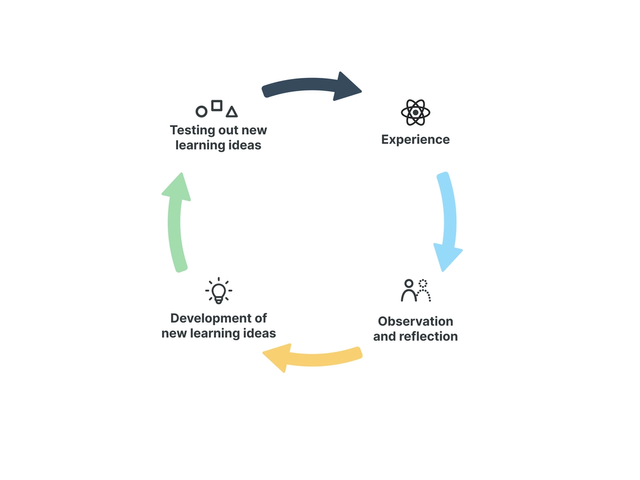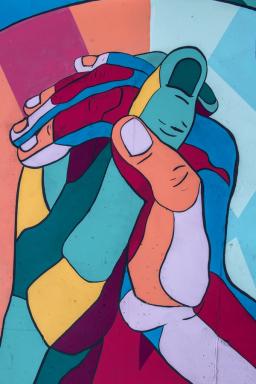Community of Practice Ideas
Listen to Mandy speak about her own path through UDL and what it means to proactively design for learner variability and iteratively reflect on this practice.
Mandy McCurdy – UDL As A Reflective Practice
[ Music ]
>> Hi. I'm Mandy McCurdy. Today I'd like to talk to you about critical reflection in your teaching practice using the UDL strategies.
Now, there are lots of great discussions and presentations about the different tools and mechanisms that we, the faculty, are using to deploy UDL strategies, but really at the core of UDL is a reflection on your own teaching practice that encourages you, as the practitioner, to think about the range of choice and options that you are providing to students. And you know often times in our reflection, we're thinking about our last class and how our most recent teaching experience went, but UDL challenges us to do that on a bigger scale. Let's think bigger than that last class and let's plan proactively. How can we use the principles from the UDL framework to guide our own reflection? And in that reflection piece, what I'd like to consider is -- what questions do we ask ourselves about our own teaching practice on an ongoing basis so that we can enhance the student experience and promote accessibility?
Now, there are lots of different people using really great platforms for many different activities in their classrooms, but those are just practices. And unless we drill down and engage in this process of reflection about our own practice, the tool or the platform really can't be utilized in a UDL way and so this is where I've come in my UDL journey because originally I was really obsessed with just telling me how to do UDL. Tell me what I need to put in my classroom so that I'm doing it correctly. And what I've come to realize is that UDL is not something that you can do or that you can't do. It's process over product. So we know the principles provide these guideposts about learner variability and, in essence, they've given us all of the dimensions of what a learner could look like and how it could vary from individual to individual. These dimensions then offer a lens through which we can reflect and ask ourselves about our own practice and our own experience.
[Music]
Mandy McCurdy on UDL as a Reflective Practice - Runtime 2:34 min
https://youtu.be/HSs5m0Vpw7M
In this course, we’ve located our learners at the centre of complex social systems that privilege a narrow range of intersectional identities and move many to the margins. By focusing the design of learning environments (conceptualized broadly across different roles we as educators occupy) on welcoming learners at the margins to co-create their education, we work towards a more inclusive educational space and more inclusive learning opportunities. We do this work by reflecting on ourselves as learners and building empathy in understanding the lived experiences of our learners in order to support them in the development of learner agency. In turn, this process is scaffolded by the three UDL principles and their corresponding guidelines and considerations. As we try out new UDL-informed strategies in our learning spaces, it’s important to recall that UDL is an ongoing reflective practice.

Remember that UDL as a practice is iterative and incremental. One great way to start small and build proficiency is the Plus-One Approach mentioned in Module 1 through the work of Tobin and Behling (2018). Plus-One is a method for quickly retrofitting existing curriculum to be more supportive. Tobin and Behling formulated this strategy to facilitate the application of UDL without starting from scratch and using what instructors can bring to the course in an efficient manner. As you’ll remember, you’re just changing one thing by making one change this term. Perhaps you’ll consider adding one more representation of an important learning material, or you may provide one more option for an assessment format. It’s a great way to begin focusing your UDL lens, making future planning faster, easier, and more impactful for subsequent semesters. As we have emphasized throughout the course, learning happens within a sociocultural context. This context can optimize learning or present barriers to learning. The same is true for our own learning, which is why you may wish to consider establishing a supportive social system within which to continue reflection on your UDL practice: a community of practice or other forms of collaborations with colleagues. You may even wish to use some of the reflections you’ve recorded in this course to begin discussions with your colleagues and students. You probably already have a rather robust archive of sources, reflections, and strategies from this course. These will be useful for discussions with peers, but also in your own pedagogical practice, scholarship of teaching and learning (SoTL) research, or teaching dossiers or portfolios.

Communities of practice are groups of people who share a concern or a passion for something they do, and learn how to do it better as they interact regularly.
There are some established communities of practice you may want to join, including the Universal Design for Learning in Higher Education: A Special Interest Group of the UDL International Research Network.
If you’d like to begin your own – perhaps with support from your centre for teaching and learning – you can download this guide from EDUCAUSE. It is beneficial to ensure this community of practice engages diverse participants, including professional roles, within the learning environment. According to Fovet (2021), advancing UDL at an institutional level requires that we work across silos to avoid overburdening any one area with forwarding UDL and to expand the pedagogical focus of UDL implementation. He writes that this ecological approach is “just as crucial and urgent to address the organizational and strategic challenges [higher education] institutions might be facing when seeking to implement change and a shift in mindset with regards to inclusion.”